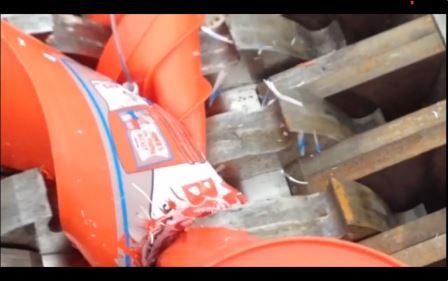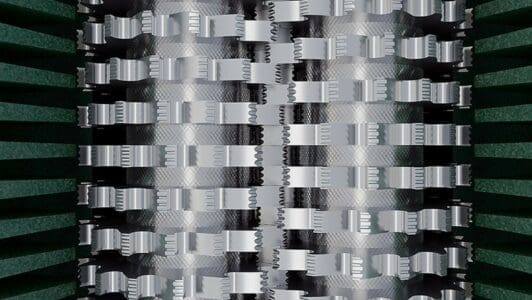
How to Select the Right Industrial Plastic Shredder
Plastic shredders can help reduce the size of industrial waste for recycling purposes and process plastics for reuse. Any manufacturer plant that has zero-waste goals will want to invest in one. However, it’s important to know that not all shredders are created equal—commercial plastic shredders are designed to handle different types of plastics, and different models will feature varying speeds, cutter sizes, torque, and specifications.
In this brief guide, we’ll cover how to select the right plastic shredder for your application.
Let’s start by providing an overview of the different types of industrial plastic shredders.
Types of Plastic Shredders
Grinder
Grinders use rotating blades to cut plastic into small pieces. They typically have a horizontal or vertical rotor with several knives attached. They are ideal for reducing plastic waste, such as bottles, pipes, and other bulky items, into granules and are often used in manufacturing plants to recycle plastic scrap from production lines.
Chipper
Chippers feature a flywheel with blades or hammers that chip the plastic material into smaller pieces. They are primarily used for processing large plastic items like crates, pallets, and thick-walled containers and are suitable for high-volume operations.
Please note that there are wood chippers—while it’s possible to shred plastic using a wood chipper, it’s not advisable. Shards of hard plastic can fly out of the chipper, causing injuries. Plastic can also jam the chipper, leading to machine damage or destruction.
Granulator
Granulators have a rotor with knives and a stationary bed knife. The plastic material is fed into the granulator, where the material is cut into small, uniform granules by the rotating and stationary knives.
They are widely used in plastic processing facilities to handle waste like film, sheets, and molded parts. They provide a consistent particle size, making them ideal for creating regrind for reuse in manufacturing.
Hammer Mill
As the name suggests, hammer mills use a series of swinging hammers attached to a rotating shaft to pulverize plastic material. They are effective at breaking tough plastics and other materials that require significant force to break. This shredder type is used in recycling operations that handle a variety of materials, including mixed plastic waste.
Shear Shredders
Shear shredders use two or more counter-rotating shafts with cutting disks. These disks create a shearing action that cuts the plastic into strips or small pieces. They are incredibly versatile and are ideal for shredding plastic drums, pipes, and other bulky items, especially in applications requiring precise size reduction.
All-Purpose Shredders
All-purpose shredders combine features of other shredding technologies to handle a wide range of materials. They have interchangeable rotors and screens to accommodate different shredding requirements. They are recommended for facilities that process various types of plastic waste, from soft films to thick, thick-walled containers.
Factors to Consider When Selecting One
Material
It’s obvious that plastic shredders are designed for use with plastics, but there are different types of plastic. Knowing your specific requirements will help narrow down your options. For example, a shear shredder or grinder might be the better option for breaking down hard, bulky, or thick plastics, while granulators are better suited for shredding thin plastics and molded parts.
Here’s a quick breakdown of shredder types and their ideal materials:
- Grinder: Hard and bulky plastics
- Chippers: Rigid plastics; high-volume waste
- Granulators: Thin-walled components; molded parts
- Hammer Mills: Tough plastics; mixed plastic waste
- Shear Shredders: Bulky, thick plastics; precision size reduction
- All-Purpose Shredders: Mixed plastic waste
The material type will also help determine how powerful the shredder needs to be. Harder, denser plastics require more power to break down effectively, so if you need to break down thick-walled containers, pipes, and tough polymers, you’ll need a shredder with higher power ratings.
Also consider the material’s form and shape (loose, baled, rigid, flexible, etc.), size and thickness, and whether there will be any impurities, like metal or dirt. These factors will influence cutter configuration.
Output Size
Next, determine the desired size of your shredded material. Is the material needed for reuse? If so, you need a shredder that provides consistent, fine particles. If the shredded plastic is used for energy recovery, larger pieces might be acceptable, depending on the combustion technology used. Additionally, different plastics have varying densities and toughness. Softer plastics may need finer shredding to ensure uniform size, while harder plastics can be left in larger pieces.
As a rule of thumb, granulators and shear shredders provide more uniform particle sizes, while grinders and hammer mills produce a range of particle sizes depending on the material being shredded.
Output size will also impact the size and configuration of the cutters used in your shredder. Larger, thicker cutters produce a coarser output and are designed to handle bigger and tougher pieces of plastic, while small, thin cutters are used for finer shredding, resulting in more uniform output particles. A higher number of blades also increases the frequency of cuts, producing finer and more uniform output.
Lastly, the machine’s screen size, cutting speed, and torque will influence output size, depending on the material being shredded. However, speed and torque will also be influenced by the material being shredded. Typically, higher rotational speed helps produce finer particles, while higher torque helps shred tougher materials.
Consult the table below for more guidance:
| Desired Output Size | Machine Type | Cutter Configuration | Screen Size |
|---|---|---|---|
| Small and uniform | Granulators and shear shredders | Higher number of blades; angled blades; small and thin blades | Smaller screen holes |
| Coarse | Grinders and hammer mills | Thicker, larger blades; blunt, straight blades | Larger screen holes |
Capacity
You also need to determine your throughput requirements. How much volume of waste is being processed daily, weekly, or monthly? How often will the shredder operate each day? Determining throughput will help you identify what capacity rating you need. We recommend selecting a shredder with a capacity that matches or slightly exceeds your throughput needs. Understanding throughput requirements will also help you know how to configure your cutters and what power you need.
As an example, if your facility processes 10 tons of plastic waste daily and operates 8 hours a day, the required throughput is 1.25 tons per hour.
Environment
Lastly, consider the environment the shredder will operate in. Will it be exposed to the elements? Do you have any space requirements? Will the environment be humid? Will the shredder need to operate efficiently in extremely high or lower temperatures? These factors will influence the construction of your shredder. For example, shredders exposed to moisture will need to be made from corrosion-resistant materials, while shredders in high-temperature environments may need integrated cooling systems to prevent overheating.
Get More Insight From a Product Specialist
Choosing the right shredder can be challenging—that’s why JWC Environmental is here to help.
Our product specialists can help you determine which shredder is best for your application. We can also customize cutter stacks based on needed output size, materials being shredded, desired capacity, and more.
Whether you need to destroy products and packaging to protect your brand or move toward a zero-waste operation, we’re committed to helping you accomplish your goals. Fill out our online form today to schedule a consultation with one of our experts, or browse our website to learn more about our available shredders.





